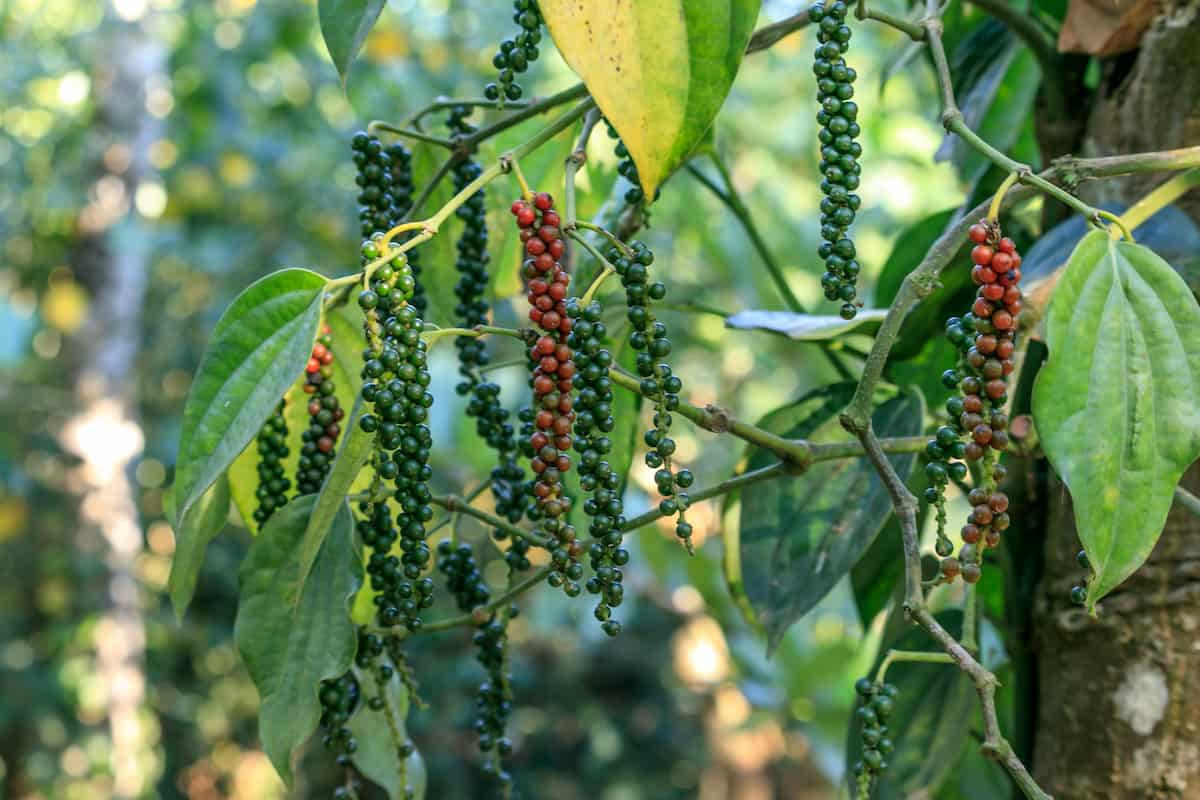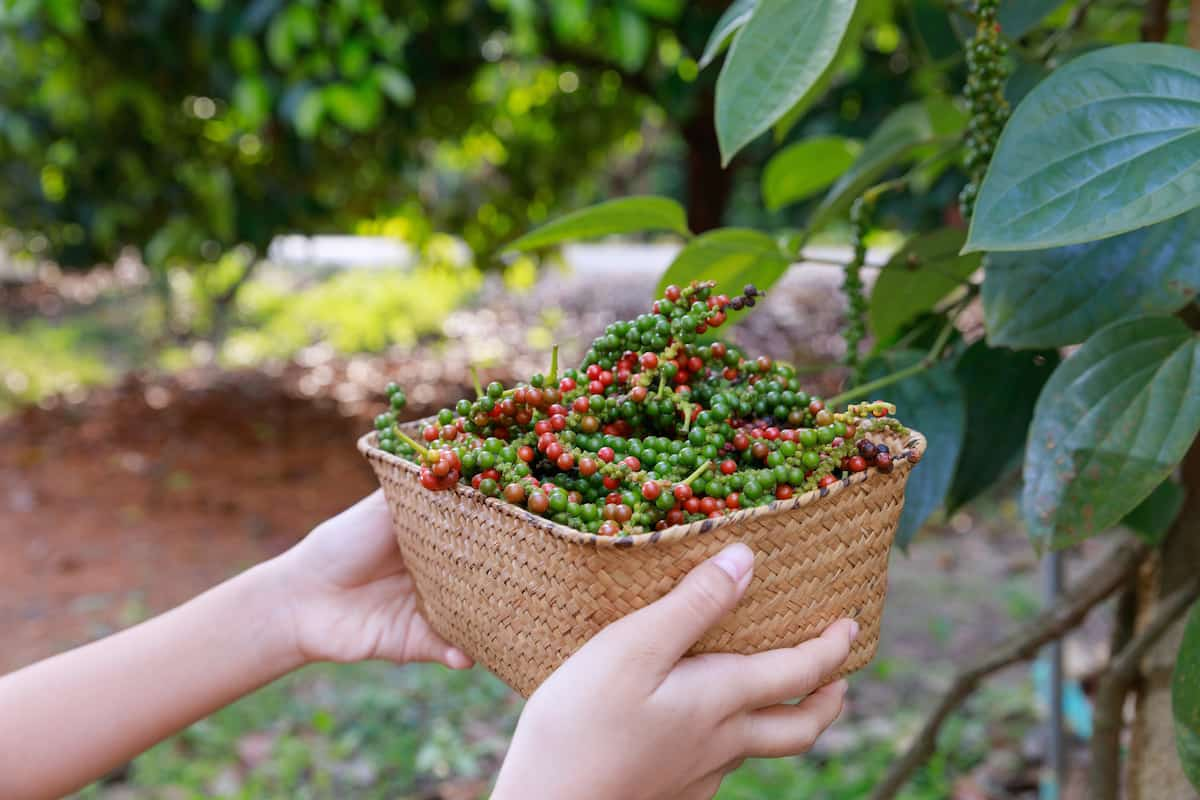Black pepper, also known as Piper nigrum, is a perennial climbing vine belonging to the Piperaceae family. It is a hot and spicy spice derived from the plant’s fruit, native to the Malabar Coast of India. The use of black pepper as a spice dates back to ancient times, making it one of the earliest spices known to humans. The black pepper is a climber that can grow up to 10 meters in height with the help of its aerial roots.

Its leaves are broad, shiny, and green, arranged alternately. The plant produces small, densely packed flowers in slender spikes, each containing approximately 50 blossoms. The fruit is also known as peppercorns. When mature, the fruit turns yellowish-red and contains a single seed. The fruit has a strong and aromatic odor, with a hot and biting taste that is very intense. Ground black pepper contains up to 3% essential oil, which gives it an aromatic flavor similar to Capsicum peppers but without the spice.
How to Grow Black Pepper from Seeds
Land/ Field Preparation and Soil Requirements for Black Pepper
Black pepper can be cultivated in various soil types, such as clay loam, red loam, sandy loam, and lateritic soils, with a pH range of 4.5 to 6.0. However, virgin soil rich in organic matter grows best in its natural habitat.
Temperature, Climatic, and Rainfall Requirements for Black Pepper
Black pepper thrives in the hot and humid climate of the sub-mountainous regions of the Western Ghats, which have high rainfall and humidity. It can be cultivated between 20° North and South latitudes, up to 1500 m above sea level, and tolerate temperatures between 10° and 40°C. The ideal temperature for growth is around 23-32°C, while a well-distributed annual rainfall of 125-200 cm is considered ideal. The optimum soil temperature for root growth is 26-28°C.
Propagation Method and Seed Quality for Black Pepper
Black pepper vines produce three shoots: primary climbing shoots with long internodes and adventitious roots that cling to supports/standards, runner shoots that originate from the vine’s base and creep on the ground, and fruit-bearing lateral shoots. Cuttings are primarily taken from runner shoots, though terminal shoots can also be used. Lateral branch cuttings result in a bushy habit. Rooted lateral branches are used to cultivate bush pepper. Although seeds are fully viable, they are not commonly used to establish plantations, as seedlings need more genetic uniformity.
Seed Treatment for Black Pepper
To treat cuttings for black pepper cultivation, dip the cut ends in a slurry of Pseudomonas flourescens culture (250 g in 750 ml of water) for 20 minutes. After treatment, plant the cuttings in polythene bags with a rate of 2-3 cuttings per bag.
Seed Rate and Spacing for Black Pepper
For one acre of black pepper plantation, 16,000 to 20,000 seedlings are needed, which requires 160-200 grams of seeds. The seeds are sown one per cell in pro-trays filled with sterilized cocopeat and covered with the same media to a depth of ½ cm.
Sowing Method for Black Pepper
During monsoon, plant 2-3 rooted black pepper cuttings in individual pits on the north side of each standard, burying at least one node for better anchorage.
Crop Rotation and Intercropping in Black Pepper
Black pepper can be grown as a mono-crop on hill slopes by clearing jungle lands and planting standards for the vines to climb on. It can also be grown as a mixed crop with areca nut, coconut, mango, and jack trees as standards. In coffee estates, pepper is a suitable intercrop as it can climb the shade trees and use them as standards.
In case you missed it: How to Grow Poblano Peppers from Seed in Containers: A Guide to Planting to Harvest

Manure & Fertilizer Applications in Black Pepper
Black pepper requires judicious and regular manuring to achieve a good yield. In April-May, 10 kg of well-rotted cattle manure or compost is recommended. For three years and above vines, 100g N, 40g P2O5, and 140g K2O fertilizers may be applied annually in two split doses in April-May and August-September.
During the first and second years of planting, 1/3 and 2/3 of the above dose may be given. The manures are applied around the vines at a distance of 30 cm and forked into the soil, and lime may be applied at the rate of 500 g per standard during April in alternate years.
Weed Management and Herbicide Application in Black Pepper
Clethodim is effective against perennial and annual grasses, with higher rates recommended for heavy pressure or larger weeds. The surfactant or crop oil concentrate should be used per the label instructions. The pre-harvest interval (PHI) is 20 days. On the other hand, Diquat can control broad leaves and grasses, but only in row middles with a maximum of 2 applications per season. A nonionic surfactant is recommended to avoid drift to the crop, and PHI is 30 days.
Water Management in Black Pepper
In black pepper farming, frequent irrigation is recommended from November to December until the end of March. Afterward, irrigation should be withheld until the monsoon break. This practice can increase pepper yield by about 50%. During winter, irrigation should be given at one-week intervals; during summer, irrigation should be given every two days.
Disease Control in Black Pepper
Black pepper farming is susceptible to various diseases, such as Quick wilt or foot rot caused by Phytophthora capsici, Pollu disease caused by Collecto-trichum gloeo-sporioides, and Slow decline or slow wilt caused by soil-borne fungi like Fusarium sp., Rhizoctonia sp., Pythium sp., Diplodea sp., and nematodes like Radopholus similis, Meloidogyne incognita.
Symptoms of these diseases range from foliar yellowing, defoliation, dieback, and decline of vines, leading to reduced productivity. Infected vines should be removed and burnt to control these diseases, and proper drainage should be provided. Fungicides like 1% Bordeaux mixture and Ridomil ziram can be sprayed, and the basin can be drenched with the same chemical twice. Phorate or carbofuran can be applied twice a year at planting time for slow decline or wilt.
Pest Control in Black Pepper
To control pollen beetle, spray endosulfan (0.05%) twice in June and September. For top shoot borer, spray endosulfan 0.05% twice when new shoots emerge. To control leaf gall thrips, spray monocrotophos 0.05%. Pollu beetle adults feed on growing points, tender shoots, leaves, tender spikes, and berries, while top shoot borer caterpillars bore into the tender shoots. Leaf gall thrips induce tubular marginal galls, causing leaves to become thick and malformed.
Harvesting and Threshing of Black Pepper
Black pepper vines flower in May-June, and the harvesting season is from November to February in the plains and January to March in the hills. Berries are separated from the spikes when one or two berries turn bright or red and are dried in the sun for 7 to 10 days. For uniform color, the berries are dipped in boiling water for one minute after being collected in a perforated bamboo basket.
In case you missed it: How to Grow Amaranth in Greenhouse: A Step-by-Step Guide for Seed to Harvest

Black Pepper Yield per Acre
A one-hectare black pepper plantation, aged 7 to 8 years, can yield approximately 800 to 1000 kg of black pepper.
Conclusion
Growing black pepper from seeds is a rewarding experience, though it requires patience and attention to detail. Even novice gardeners can grow their black pepper by selecting high-quality seeds, providing optimal conditions, and carefully tending to the plants.
- Feed Your Flock for Less: Top 10 Tips to Save on Chicken Feed
- Ultimate Guide to Ossabaw Island Hog: Breeding, Raising, Diet, and Care
- Hatching Answers: The Top 10 Reasons Your Chickens Aren’t Laying Eggs
- Eggs and Economics: Breaking Down the Cost of Raising Backyard Chickens
- Defend Your Greens: Proven Methods to Keep Iguanas Out of Your Garden
- Ultimate Guide to Cinnamon Queen Chicken: A Comprehensive Guide for Beginners
- Ultimate Guide to California Tan Chicken: Breeding, Raising, Diet, Egg-Production and Care
- Ultimate Guide to Marsh Daisy Chicken: Breeding, Raising, Diet, and Care
- 10 Types of Chicken Farming Businesses You Can Start for Profits